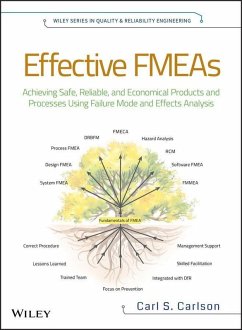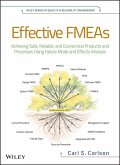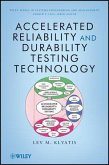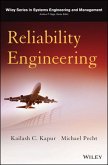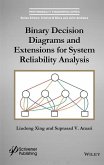Effective FMEAs (eBook, ePUB)
Achieving Safe, Reliable, and Economical Products and Processes using Failure Mode and Effects Analysis


Alle Infos zum eBook verschenken

Effective FMEAs (eBook, ePUB)
Achieving Safe, Reliable, and Economical Products and Processes using Failure Mode and Effects Analysis
- Format: ePub
- Merkliste
- Auf die Merkliste
- Bewerten Bewerten
- Teilen
- Produkt teilen
- Produkterinnerung
- Produkterinnerung

Hier können Sie sich einloggen

Bitte loggen Sie sich zunächst in Ihr Kundenkonto ein oder registrieren Sie sich bei bücher.de, um das eBook-Abo tolino select nutzen zu können.
Outlines the correct procedures for doing FMEAs and how to successfully apply them in design, development, manufacturing, and service applications There are a myriad of quality and reliability tools available to corporations worldwide, but the one that shows up consistently in company after company is Failure Mode and Effects Analysis (FMEA). Effective FMEAs takes the best practices from hundreds of companies and thousands of FMEA applications and presents streamlined procedures for veteran FMEA practitioners, novices, and everyone in between. Written from an applications viewpoint--with many…mehr
- Geräte: eReader
- mit Kopierschutz
- eBook Hilfe
- Größe: 14.86MB
![Effective FMEAs (eBook, PDF) Effective FMEAs (eBook, PDF)]() Carl CarlsonEffective FMEAs (eBook, PDF)119,99 €
Carl CarlsonEffective FMEAs (eBook, PDF)119,99 €![Accelerated Reliability and Durability Testing Technology (eBook, ePUB) Accelerated Reliability and Durability Testing Technology (eBook, ePUB)]() Lev M. KlyatisAccelerated Reliability and Durability Testing Technology (eBook, ePUB)111,99 €
Lev M. KlyatisAccelerated Reliability and Durability Testing Technology (eBook, ePUB)111,99 €![Probability Concepts and Theory for Engineers (eBook, ePUB) Probability Concepts and Theory for Engineers (eBook, ePUB)]() Harry SchwarzlanderProbability Concepts and Theory for Engineers (eBook, ePUB)71,99 €
Harry SchwarzlanderProbability Concepts and Theory for Engineers (eBook, ePUB)71,99 €![Product Maturity 1 (eBook, ePUB) Product Maturity 1 (eBook, ePUB)]() Franck BayleProduct Maturity 1 (eBook, ePUB)139,99 €
Franck BayleProduct Maturity 1 (eBook, ePUB)139,99 €![Reliability Engineering (eBook, ePUB) Reliability Engineering (eBook, ePUB)]() Kailash C. KapurReliability Engineering (eBook, ePUB)131,99 €
Kailash C. KapurReliability Engineering (eBook, ePUB)131,99 €![Binary Decision Diagrams and Extensions for System Reliability Analysis (eBook, ePUB) Binary Decision Diagrams and Extensions for System Reliability Analysis (eBook, ePUB)]() Liudong XingBinary Decision Diagrams and Extensions for System Reliability Analysis (eBook, ePUB)153,99 €
Liudong XingBinary Decision Diagrams and Extensions for System Reliability Analysis (eBook, ePUB)153,99 €![Applied Reliability Engineering and Risk Analysis (eBook, ePUB) Applied Reliability Engineering and Risk Analysis (eBook, ePUB)]() Ilia B. FrenkelApplied Reliability Engineering and Risk Analysis (eBook, ePUB)132,99 €
Ilia B. FrenkelApplied Reliability Engineering and Risk Analysis (eBook, ePUB)132,99 €-
-
-
Dieser Download kann aus rechtlichen Gründen nur mit Rechnungsadresse in A, B, BG, CY, CZ, D, DK, EW, E, FIN, F, GR, HR, H, IRL, I, LT, L, LR, M, NL, PL, P, R, S, SLO, SK ausgeliefert werden.
Hinweis: Dieser Artikel kann nur an eine deutsche Lieferadresse ausgeliefert werden.
- Produktdetails
- Verlag: Wiley
- Seitenzahl: 464
- Erscheinungstermin: 11. April 2012
- Englisch
- ISBN-13: 9781118312582
- Artikelnr.: 38260116
- Verlag: Wiley
- Seitenzahl: 464
- Erscheinungstermin: 11. April 2012
- Englisch
- ISBN-13: 9781118312582
- Artikelnr.: 38260116
- Herstellerkennzeichnung Die Herstellerinformationen sind derzeit nicht verfügbar.
Copyrights and Permissions xix
Acknowledgments xxi
Introduction xxiii
Chapter 1 The Case for Failure Mode and Effects Analysis 1
In This Chapter 1
1.1 The Need for Effective FMEAs 1
1.2 FMEA Application by Industry 4
1.3 The Factor of 10 Rule 5
1.4 FMEA Successes 6
1.5 Brief History of FMEA 8
1.6 FMEA Standards and Guidelines 8
1.7 How to Use This Book 9
1.8 Web Companion to Effective FMEAs 10
1.9 End of Chapter Problems 10
References 11
Chapter 2 The Philosophy and Guiding Principles for Effective FMEAs 12
In This Chapter 12
2.1 What Is Philosophy and Why Does It Matter to FMEAs? 12
2.2 Guiding Principles for Effective FMEAs 13
2.3 The Role of FMEA in Design for Reliability 17
2.4 You Can't Anticipate Everything 18
2.5 End of Chapter Problems 19
References 20
Chapter 3 Understanding the Fundamental Definitions and Concepts of FMEAs
21
In This Chapter 21
3.1 Definition of FMEA 21
3.2 Primary Objective of FMEA 22
3.3 Definition of Failure Mode Effects and Criticality Analysis 22
3.4 Types of FMEAs 23
3.5 FMEA Definitions and Examples 25
3.6 Is It a Failure Mode, Effect, or Cause? 48
3.7 FMEA Glossary 49
3.8 Web Companion to Effective FMEAs 51
3.9 End of Chapter Problems 51
References 55
Chapter 4 Selection and Timing of FMEA Projects 56
In This Chapter 56
4.1 Guidelines for When to Do FMEAs 56
4.2 FMEA Project Selection Criteria 58
4.3 Preliminary Risk Assessment 59
4.4 When to Do Different Types of FMEAs 60
4.5 Responsibility for FMEAs between OEMs and Suppliers 62
4.6 Introducing the All-Terrain Bicycle Case Study 63
4.7 End of Chapter Problems 64
Chapter 5 How to Perform an FMEA Project: Preparation 66
In This Chapter 66
Use of the Bicycle Examples in the Chapter 66
5.1 The Subject of FMEA Preparation 67
5.2 Preparation Tasks Done Once for All FMEA Projects 67
5.3 Preparation Tasks for Each New FMEA Project 78
5.4 End of Chapter Problems 103
References 106
Chapter 6 How to Perform an FMEA Project: Procedure 107
In This Chapter 107
Use of the Bicycle Examples in the Chapter 107
6.1 FMEA Procedure Sequence of Steps 108
6.2 Basic FMEA Procedure 109
6.3 FMEA Linkages 152
6.4 End of Chapter Problems 158
References 161
Chapter 7 How to Develop and Execute Effective Risk Reduction Actions 162
In This Chapter 162
Use of the Bicycle Examples in the Chapter 162
7.1 Prioritize Issues for Corrective Action 163
7.2 Develop Effective Recommended Actions 165
7.3 Action Strategies to Reduce Risk 166
7.4 Examples of Recommended Actions 176
7.5 FMEA Execution Enablers 176
7.6 The Essence of Execution 182
7.7 Documenting Actions Taken 182
7.8 Ensuring Risk Is Reduced to an Acceptable Level 183
7.9 End of Chapter Problems 183
References 186
Chapter 8 Case Studies 187
In This Chapter 187
8.1 Case Study: Shock Absorber Assembly 188
8.2 Case Study: Strudel Pastry Manufacturing 190
8.3 Case Study: Motorola Solutions "Press-to-Talk" Feature 193
8.4 Case Study: Flashlight 200
8.5 Case Study: DC-10 Cargo Door Failure 200
8.6 Case Study: Space Shuttle Challenger O-Ring Failure 204
8.7 Case Study: Projector Lamp 206
8.8 Case Study: All-Terrain Bicycle 206
8.9 Case Study: Resin Lever 213
8.10 Case Study: Power Steering 217
8.11 Other Case Studies and Examples 217
8.12 Web Companion to Effective FMEAs 221
8.13 End of Chapter Problems 221
References 224
Chapter 9 Lessons Learned for Effective FMEAs 226
In This Chapter 226
9.1 The Most Common FMEA Mistakes: How to Avoid Them and Audit Them 226
9.2 Summary of FMEA Quality Objectives 235
9.3 FMEA Quality Audit Procedure 235
9.4 End of Chapter Problems 236
Chapter 10 How to Facilitate Successful FMEA Projects 241
In This Chapter 241
10.1 FMEA Facilitation 241
10.2 Effective Meetings 242
10.3 Primary FMEA Facilitation Skills 243
10.4 Unleashing Team Creativity 252
10.5 FMEA Facilitation Roles and Responsibilities 255
10.6 How to Reduce FMEA In-Meeting Time 261
10.7 Difficulty Getting Consensus on Competing Ideas 261
10.8 End of Chapter Problems 263
References 265
Chapter 11 Implementing an Effective Company-Wide FMEA Process 266
In This Chapter 266
11.1 What is a Company-Wide FMEA Process and Why is it Important? 266
11.2 Management Roles and Responsibilities 267
11.3 Effective FMEA Process 268
11.4 Lessons Learned in Implementing a Company-Wide FMEA Process 279
11.5 Company Climate for Sharing Failure Information 281
11.6 End of Chapter Problems 282
Chapter 12 Failure Mode Effects and Criticality Analysis (FMECA) 285
In This Chapter 285
12.1 Introduction to FMECA 285
12.2 When to Use FMECA 286
12.3 Brief History of FMECA 286
12.4 Types of FMECA 287
12.5 Quantitative Criticality Analysis 287
12.6 Qualitative Criticality Analysis 289
12.7 FMECA Criticality Matrix 292
12.8 FMECA Worksheet 292
12.9 Summary Output of FMECA 292
12.10 End of Chapter Problems 294
References 296
Chapter 13 Introduction to Design Review Based on Failure Mode (DRBFM) 297
In This Chapter 297
13.1 What Is DRBFM? 297
13.2 Change Point Analysis 300
13.3 Conducting DRBFM Projects 302
13.4 How DRBFM Integrates with FMEA 304
13.5 DRBFM Worksheet 304
13.6 DRBFM Examples and Case Studies 304
13.7 Design Review Based on Test Results 309
13.8 DRBFM Glossary 311
13.9 DRBFM Resources for Further Study 312
13.10 End of Chapter Problems 313
References 315
Chapter 14 Introduction to Fault Tree Analysis (FTA) 316
In This Chapter 316
14.1 What Is Fault Tree Analysis? 316
14.2 FTA and FMEA 317
14.3 Brief History of FTA 318
14.4 Models 318
14.5 Events and Gates 318
14.6 FTA Example 319
14.7 FTA Glossary 320
14.8 FTA Procedure 323
14.9 FTA Handbooks and Standards 324
14.10 Use of FTA on Software 324
14.11 FTA Benefits and Limitations 324
14.12 End of Chapter Problems 326
References 327
Chapter 15 Other FMEA Applications 328
In This Chapter 328
15.1 Reliability-Centered Maintenance 328
15.2 Hazard Analysis 340
15.3 Concept FMEA 347
15.4 Software FMEA 348
15.5 Failure Modes, Mechanisms, and Effects Analysis 356
15.6 Failure Modes, Effects, and Diagnostic Analysis 358
15.7 End of Chapter Problems 361
References 363
Chapter 16 Selecting the Right FMEA Software 365
In This Chapter 365
16.1 Characteristics of Excellent FMEA Software 365
16.2 Why Not Just Use Spreadsheet Software? 368
16.3 Advantages of Relational Database 368
16.4 Using the Criteria for Selecting Relational Database Software 369
16.5 End of Chapter Problems 369
Reference 370
Appendices 371
Appendix A FMEA Scales 371
Appendix B FMEA Worksheet Forms 376
B.1 Design FMEA Worksheet Forms 377
B.2 Process FMEA Worksheet Forms 382
Appendix C All-Terrain Bicycle Documents 388
Appendix D Lists and Checklists 392
D.1 FMEA Preparation Checklists 392
Checklist 393
D.2 Lists of Failure Mechanisms (excerpts from book) 396
D.3 FMEA Quality Objectives 399
D.4 FMEA Facilitation Checklists 400
D.5 FMEA Action Strategy Checklist 405
D.6 FMEA Quality Audit Procedure 409
D.7 FMEA Quality Survey Form 413
Appendix E FMEA Glossary 414
References 418
Index 419
Copyrights and Permissions xix
Acknowledgments xxi
Introduction xxiii
Chapter 1 The Case for Failure Mode and Effects Analysis 1
In This Chapter 1
1.1 The Need for Effective FMEAs 1
1.2 FMEA Application by Industry 4
1.3 The Factor of 10 Rule 5
1.4 FMEA Successes 6
1.5 Brief History of FMEA 8
1.6 FMEA Standards and Guidelines 8
1.7 How to Use This Book 9
1.8 Web Companion to Effective FMEAs 10
1.9 End of Chapter Problems 10
References 11
Chapter 2 The Philosophy and Guiding Principles for Effective FMEAs 12
In This Chapter 12
2.1 What Is Philosophy and Why Does It Matter to FMEAs? 12
2.2 Guiding Principles for Effective FMEAs 13
2.3 The Role of FMEA in Design for Reliability 17
2.4 You Can't Anticipate Everything 18
2.5 End of Chapter Problems 19
References 20
Chapter 3 Understanding the Fundamental Definitions and Concepts of FMEAs
21
In This Chapter 21
3.1 Definition of FMEA 21
3.2 Primary Objective of FMEA 22
3.3 Definition of Failure Mode Effects and Criticality Analysis 22
3.4 Types of FMEAs 23
3.5 FMEA Definitions and Examples 25
3.6 Is It a Failure Mode, Effect, or Cause? 48
3.7 FMEA Glossary 49
3.8 Web Companion to Effective FMEAs 51
3.9 End of Chapter Problems 51
References 55
Chapter 4 Selection and Timing of FMEA Projects 56
In This Chapter 56
4.1 Guidelines for When to Do FMEAs 56
4.2 FMEA Project Selection Criteria 58
4.3 Preliminary Risk Assessment 59
4.4 When to Do Different Types of FMEAs 60
4.5 Responsibility for FMEAs between OEMs and Suppliers 62
4.6 Introducing the All-Terrain Bicycle Case Study 63
4.7 End of Chapter Problems 64
Chapter 5 How to Perform an FMEA Project: Preparation 66
In This Chapter 66
Use of the Bicycle Examples in the Chapter 66
5.1 The Subject of FMEA Preparation 67
5.2 Preparation Tasks Done Once for All FMEA Projects 67
5.3 Preparation Tasks for Each New FMEA Project 78
5.4 End of Chapter Problems 103
References 106
Chapter 6 How to Perform an FMEA Project: Procedure 107
In This Chapter 107
Use of the Bicycle Examples in the Chapter 107
6.1 FMEA Procedure Sequence of Steps 108
6.2 Basic FMEA Procedure 109
6.3 FMEA Linkages 152
6.4 End of Chapter Problems 158
References 161
Chapter 7 How to Develop and Execute Effective Risk Reduction Actions 162
In This Chapter 162
Use of the Bicycle Examples in the Chapter 162
7.1 Prioritize Issues for Corrective Action 163
7.2 Develop Effective Recommended Actions 165
7.3 Action Strategies to Reduce Risk 166
7.4 Examples of Recommended Actions 176
7.5 FMEA Execution Enablers 176
7.6 The Essence of Execution 182
7.7 Documenting Actions Taken 182
7.8 Ensuring Risk Is Reduced to an Acceptable Level 183
7.9 End of Chapter Problems 183
References 186
Chapter 8 Case Studies 187
In This Chapter 187
8.1 Case Study: Shock Absorber Assembly 188
8.2 Case Study: Strudel Pastry Manufacturing 190
8.3 Case Study: Motorola Solutions "Press-to-Talk" Feature 193
8.4 Case Study: Flashlight 200
8.5 Case Study: DC-10 Cargo Door Failure 200
8.6 Case Study: Space Shuttle Challenger O-Ring Failure 204
8.7 Case Study: Projector Lamp 206
8.8 Case Study: All-Terrain Bicycle 206
8.9 Case Study: Resin Lever 213
8.10 Case Study: Power Steering 217
8.11 Other Case Studies and Examples 217
8.12 Web Companion to Effective FMEAs 221
8.13 End of Chapter Problems 221
References 224
Chapter 9 Lessons Learned for Effective FMEAs 226
In This Chapter 226
9.1 The Most Common FMEA Mistakes: How to Avoid Them and Audit Them 226
9.2 Summary of FMEA Quality Objectives 235
9.3 FMEA Quality Audit Procedure 235
9.4 End of Chapter Problems 236
Chapter 10 How to Facilitate Successful FMEA Projects 241
In This Chapter 241
10.1 FMEA Facilitation 241
10.2 Effective Meetings 242
10.3 Primary FMEA Facilitation Skills 243
10.4 Unleashing Team Creativity 252
10.5 FMEA Facilitation Roles and Responsibilities 255
10.6 How to Reduce FMEA In-Meeting Time 261
10.7 Difficulty Getting Consensus on Competing Ideas 261
10.8 End of Chapter Problems 263
References 265
Chapter 11 Implementing an Effective Company-Wide FMEA Process 266
In This Chapter 266
11.1 What is a Company-Wide FMEA Process and Why is it Important? 266
11.2 Management Roles and Responsibilities 267
11.3 Effective FMEA Process 268
11.4 Lessons Learned in Implementing a Company-Wide FMEA Process 279
11.5 Company Climate for Sharing Failure Information 281
11.6 End of Chapter Problems 282
Chapter 12 Failure Mode Effects and Criticality Analysis (FMECA) 285
In This Chapter 285
12.1 Introduction to FMECA 285
12.2 When to Use FMECA 286
12.3 Brief History of FMECA 286
12.4 Types of FMECA 287
12.5 Quantitative Criticality Analysis 287
12.6 Qualitative Criticality Analysis 289
12.7 FMECA Criticality Matrix 292
12.8 FMECA Worksheet 292
12.9 Summary Output of FMECA 292
12.10 End of Chapter Problems 294
References 296
Chapter 13 Introduction to Design Review Based on Failure Mode (DRBFM) 297
In This Chapter 297
13.1 What Is DRBFM? 297
13.2 Change Point Analysis 300
13.3 Conducting DRBFM Projects 302
13.4 How DRBFM Integrates with FMEA 304
13.5 DRBFM Worksheet 304
13.6 DRBFM Examples and Case Studies 304
13.7 Design Review Based on Test Results 309
13.8 DRBFM Glossary 311
13.9 DRBFM Resources for Further Study 312
13.10 End of Chapter Problems 313
References 315
Chapter 14 Introduction to Fault Tree Analysis (FTA) 316
In This Chapter 316
14.1 What Is Fault Tree Analysis? 316
14.2 FTA and FMEA 317
14.3 Brief History of FTA 318
14.4 Models 318
14.5 Events and Gates 318
14.6 FTA Example 319
14.7 FTA Glossary 320
14.8 FTA Procedure 323
14.9 FTA Handbooks and Standards 324
14.10 Use of FTA on Software 324
14.11 FTA Benefits and Limitations 324
14.12 End of Chapter Problems 326
References 327
Chapter 15 Other FMEA Applications 328
In This Chapter 328
15.1 Reliability-Centered Maintenance 328
15.2 Hazard Analysis 340
15.3 Concept FMEA 347
15.4 Software FMEA 348
15.5 Failure Modes, Mechanisms, and Effects Analysis 356
15.6 Failure Modes, Effects, and Diagnostic Analysis 358
15.7 End of Chapter Problems 361
References 363
Chapter 16 Selecting the Right FMEA Software 365
In This Chapter 365
16.1 Characteristics of Excellent FMEA Software 365
16.2 Why Not Just Use Spreadsheet Software? 368
16.3 Advantages of Relational Database 368
16.4 Using the Criteria for Selecting Relational Database Software 369
16.5 End of Chapter Problems 369
Reference 370
Appendices 371
Appendix A FMEA Scales 371
Appendix B FMEA Worksheet Forms 376
B.1 Design FMEA Worksheet Forms 377
B.2 Process FMEA Worksheet Forms 382
Appendix C All-Terrain Bicycle Documents 388
Appendix D Lists and Checklists 392
D.1 FMEA Preparation Checklists 392
Checklist 393
D.2 Lists of Failure Mechanisms (excerpts from book) 396
D.3 FMEA Quality Objectives 399
D.4 FMEA Facilitation Checklists 400
D.5 FMEA Action Strategy Checklist 405
D.6 FMEA Quality Audit Procedure 409
D.7 FMEA Quality Survey Form 413
Appendix E FMEA Glossary 414
References 418
Index 419
